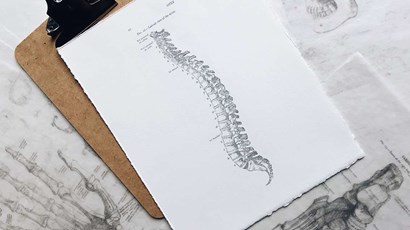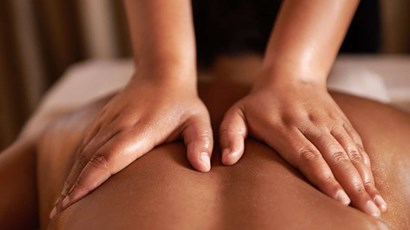Back pain in children occurs quite often and seems to be increasingly common. Most of the time this is not a serious problem.
There's a whole range of conditions that can cause back pain in older children, including overuse, carrying heavy backpacks, and sprains and stress fractures. Less common causes of back pain include slipped discs and inflammatory diseases.
Which children are prone to back pain?
Back pain in children is becoming more common. It affects girls more than boys. However, it isn't seen as often in children as in adults. About 30 in 100 children and young people experience back pain, but very few go to see their doctor.
What are the symptoms of back pain in children?
Back pain is felt as a discomfort in the back.
- It can be a short fleeting pain or a pain that lasts for a long time.
- It can be mild or severe. It can stay in the centre of the back or travel (radiate) to other areas such as the arms or legs.
- It can sometimes keep your child awake at night. This can affect their performance at school.
- The back pain can make them feel miserable.
- The back pain may affect your child's ability to play games or do PE.
- You can sometimes identify activities that make the pain worse, such as lifting and carrying, or make it better, such as rest. Sometimes the pain level changes for no obvious reason.
- You or your child may notice other symptoms, such as a high temperature (fever), weakness, numbness, pins and needles, or problems with their bowels or waterworks.
- It can affect the way they walk, bend and move.
- You might find a tender spot in the middle of their back.
- You may also notice that their back starts to look twisted or curved.
What are the causes of back pain in children?
It used to be thought that back pain in children often had a serious cause. However, it is now realised that many children and teenagers have back pain without there being any underlying worrying condition. One study showed that no cause for back pain could be found in 78 out of 100 children, despite them having lots of tests. This doesn't mean that serious causes should be forgotten and it's important to strike a balance between looking for serious conditions and subjecting children to unnecessary and sometimes unpleasant tests, in particular X-rays which give a high dose of radiation.
Older children
- Muscle strain or strain of ligaments of the spine due to a repeated movement (for example, sports, dancing).
- A slipped disc, Scheuermann's disease (a condition in which uneven growth of the small bones (vertebrae) making up the spine causes curvature of the spine).
- Vertebral fractures.
- Spondylolysis (wear and tear in the spine, commonly seen in sporty teenagers).
- Spondylolisthesis (slippage of a vertebra frontwards or backwards, often a complication of spondylolysis).
- Ankylosing spondylitis.
Younger children and older children
- Infection - usually in those aged under 10 years:
- Discitis - infection of a disc.
- Osteomyelitis.
- Pyelonephritis.
- Retroperitoneal infection - infection underneath the peritoneum, the membrane lining the abdominal cavity.
- Rarely, tumours of the bone or spinal cord.
- Congenital disorders - conditions your child is born with (for example, scoliosis, which can be congenital or can come on later in life).
- Diseases affecting the whole body - for example, sickle cell disease.
How is back pain in children diagnosed?
Back pain is common and often nothing to worry about. However, there are occasions when you need to take your child to the doctor.
When should my child see a doctor?
There are a number of situations in which your child should see a doctor:
- If they are under 4 years old.
- If their back pain goes on for more than four weeks.
- If their back pain stops them from doing things.
- If they feel unwell and/or have a high temperature (fever) or weight loss.
- If the pain is getting worse.
- If they have pins and needles, numbness or weakness.
- If they start developing curvature of the spine.
- If they start complaining of stiffness or difficulty in moving.
What will the doctor do?
The doctor will ask you or your child questions about their back pain and general health (see the section on Symptoms).
The doctor will physically examine your child. They may want to check:
- The site of the pain.
- The site of any tenderness.
- The appearance of your child's back (looking for unusual features such as muscle wasting or curvature).
- The way your child walks..
- How much your child can bend their back..
- Your child's nervous system (including signs of weakness or numbness).
Will my child need any tests?
Once the doctor has obtained information about your child's symptoms and examined them, they will occasionally want to do some tests - for example a blood test or an X-ray.
Occasionally your child will need more complicated tests, which will need to be requested by a specialist. This may include:
- A bone scan - this is a scan of the bones after a small amount of dye is injected into your child's vein. The needle used is very small and doesn't usually cause much, if any, discomfort.
- Other more complicated scans, such as a magnetic resonance imaging (MRI) scan or a computerised tomography (CT) scan, are sometimes required.
What treatment options are available for a child with back pain?
In many children, back pain is short-lived and settles down without treatment. Studies have found that this happens in about half of all teenagers with back pain, and it's usually due to over-enthusiastic sporting activities or the use of backpacks.
If the back pain is persistent it's important to investigate the cause. Simple painkillers such as paracetamol or ibuprofen may help. Your child may be referred to a physiotherapist who will advise about any changes which can be made to your child's lifestyle to relieve the pain and stop it from happening again. They may also provide various forms of physical treatment and advise a course of exercises that can be done at home,.
If your child's pain lasts longer than 4-6 weeks, is getting worse, or is accompanied by unusual features such as a persistent high temperature (fever) or numbness, they may be referred to a specialist. If there is a serious cause, it is usually important to start treatment as soon as possible. The treatment advised by the specialist will depend on the cause.
Does back pain in children have any complications?
In many cases, the back pain goes away without any treatment and there are no complications. It is important to diagnose serious causes so that treatment can be started sooner rather than later. Otherwise it is possible that back pain may become persistent or that a complication such as curvature may develop. If the child develops long-term back pain, they may become depressed and unable to do some of the things that children enjoy, such as playing games and taking part in sports.
Can back pain in children be prevented?
It turns out that when our mothers told us to stop slouching they were giving us good medical advice. Back pain can often be avoided by sitting and standing properly, ie, correcting poor posture. Lifting properly and avoiding repeated actions which strain the spine (such as over-exertion during sports) can also be helpful.
Keeping your child happy and stress-free is often easier said than done, but mental health difficulties are known to be associated with back pain.
Backpacks are often a cause of back pain in children and adolescents. Make sure they are not too heavy and the weight is equally distributed (for example, by carrying the backpack on two shoulders rather than one). If a locker is available, encourage your child to use it. Swimming is helpful but there is little evidence to suggest that other sporting activities prevent back pain. Be sensible about the amount of exercise your child does.
Further reading and references
Taxter AJ, Chauvin NA, Weiss PF; Diagnosis and treatment of low back pain in the pediatric population. Phys Sportsmed. 2014 Feb42(1):94-104. doi: 10.3810/psm.2014.02.2052.
Ramirez N, Flynn JM, Hill BW, et al; Evaluation of a systematic approach to pediatric back pain: the utility of magnetic resonance imaging. J Pediatr Orthop. 2015 Jan35(1):28-32. doi: 10.1097/BPO.0000000000000190.
Spiteri K, Busuttil ML, Aquilina S, et al; Schoolbags and back pain in children between 8 and 13 years: a national study. Br J Pain. 2017 May11(2):81-86. doi: 10.1177/2049463717695144. Epub 2017 Feb 1.



